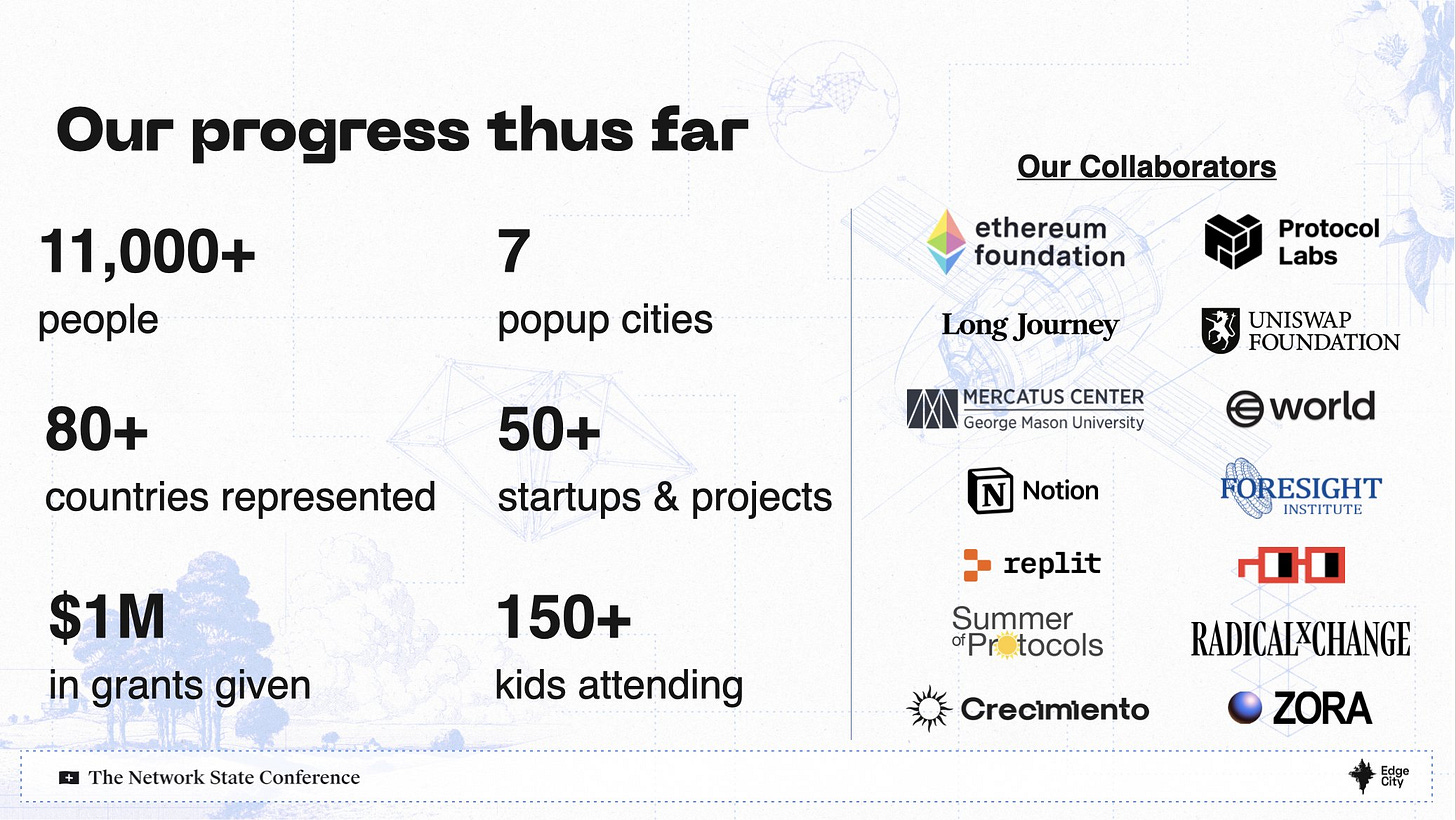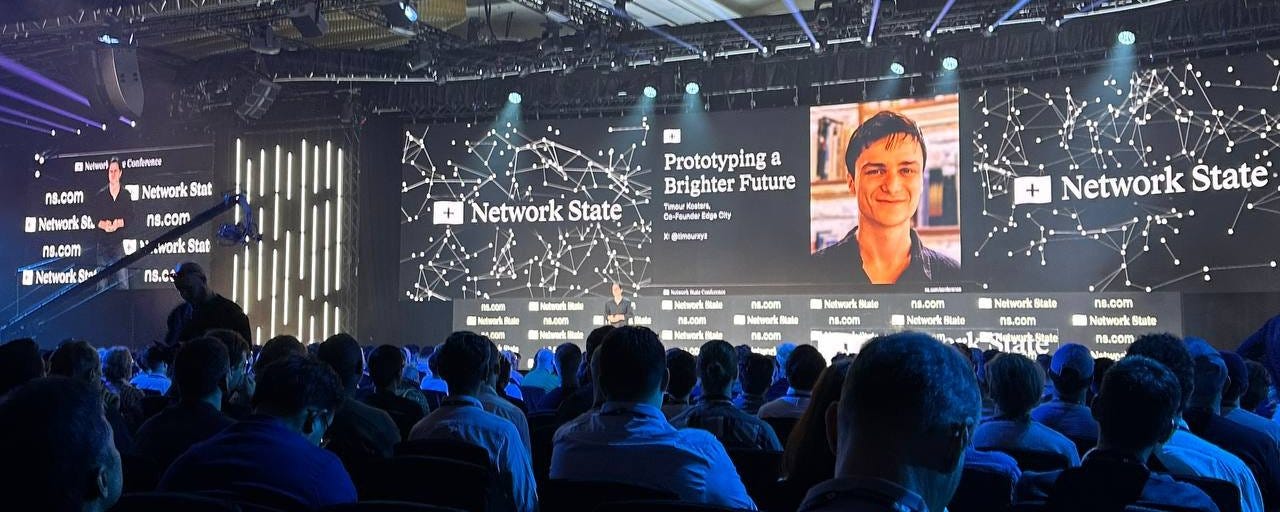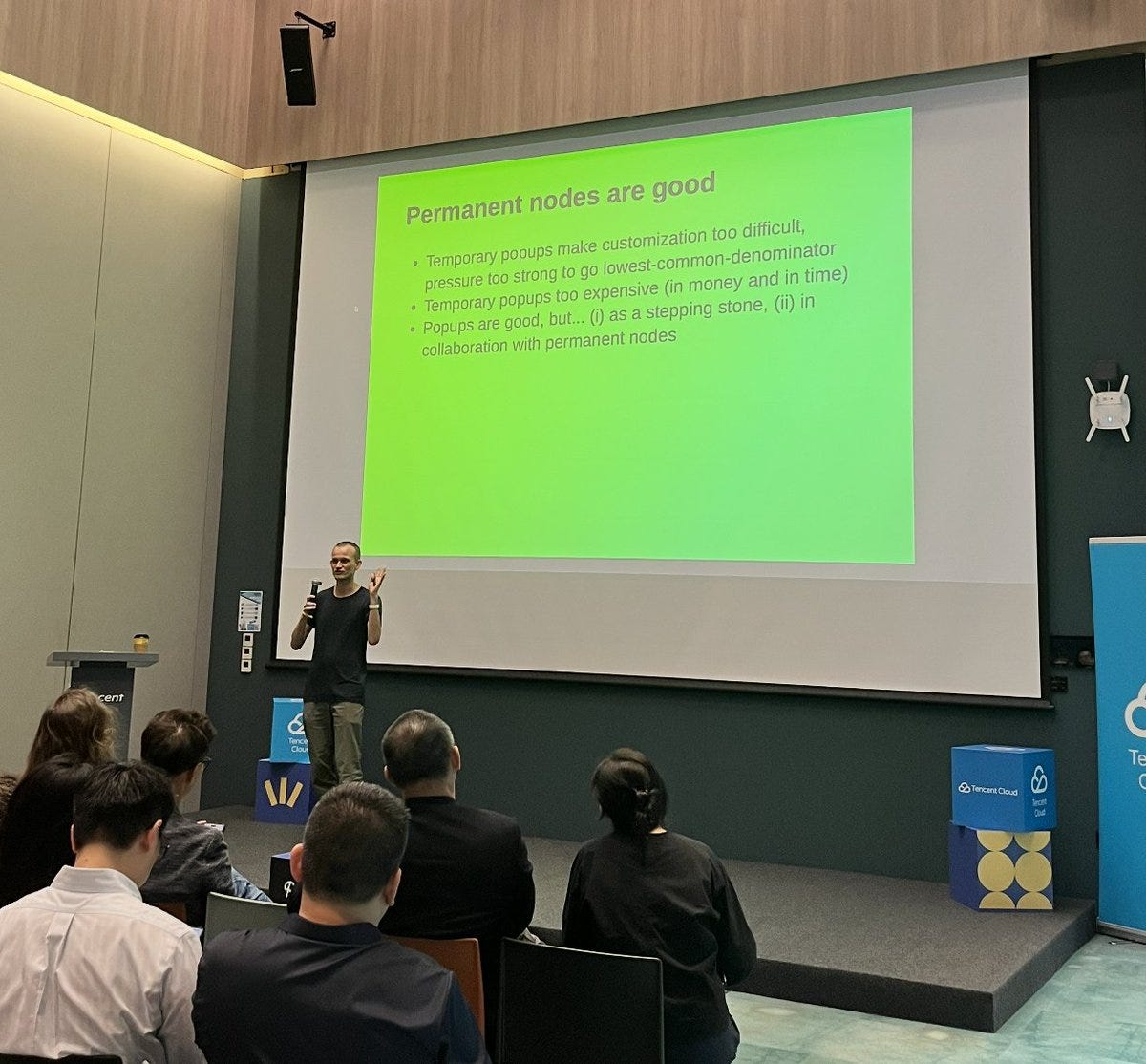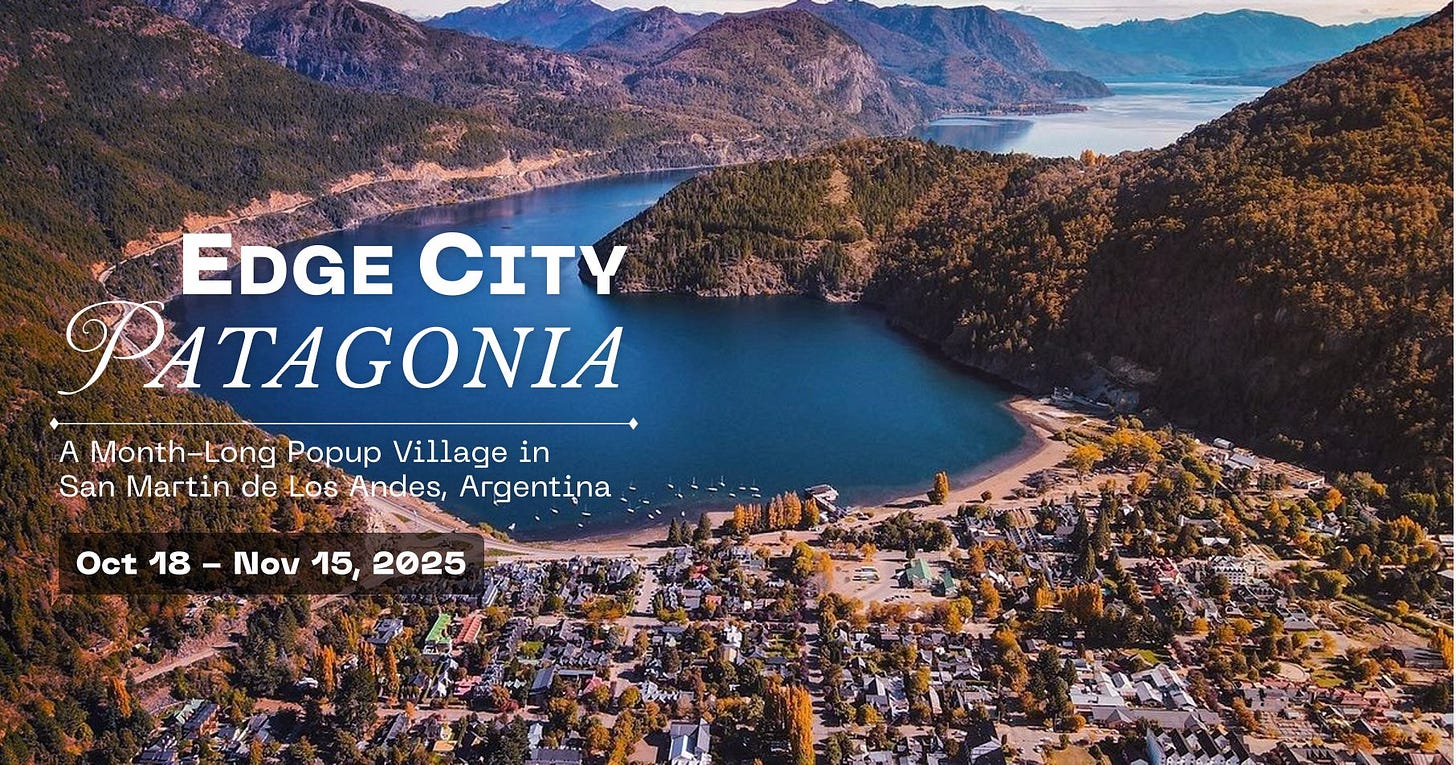Reflections from the Network State Conference
Notes from Singapore on a movement that is moving from theory to execution
I’m flying home from the Network State Conference in Singapore, and I want to share my reflections while they’re still fresh. If you want to watch my talk, you can do so here.
TLDR
The network state movement is moving beyond a niche and feels increasingly real. Projects are doing substantial work in the world with genuine citizenship bases and momentum, and there is a growing set of investors and sovereigns paying attention.
The event drew 3,500 people, and the auditorium remained full for the entire 10-hour program, a rarity at conferences these days. The programming was multidisciplinary and of high quality, and the event itself was very well-organized. Huge props to Balaji, Jackson, and the rest of the NS team, and I’m looking forward to next year.
Quick context on network states (/ network societies / network cities)
Put simply, a network state is an online community that materializes in the physical world with the goal of achieving meaningful collective action. The idea is that groups of like-minded people distributed globally can organize themselves into something resembling a nation—providing services, governance, and infrastructure for their members across multiple physical locations.
My organization, Edge City, is building something that could resemble a network state in the future, although I often use ‘network city’ or ‘network society’ as interchangeable terms to describe what we’re building because we’re less focused on the more state-like functions.
Why does this matter now? If this works, it offers an alternative to the growing dysfunction in many traditional nation-states and a way for people to opt into communities that align with their values. At Edge, we view this as an opportunity to experiment with new society-level infrastructure, such as governance mechanisms, new education and economic systems, and ways of living meaningful lives in flourishing communities.
It’s clear that we need new institutions and cultures to face the challenges and opportunities of our time. I don’t think they will come from traditional thinktanks or accelerators; instead they’ll be incubated by groups of high-agency people who take time away from the mainstream to experiment, and then merge their learnings back into society. That’s a large part of our motivation for starting Edge City.

The Event Itself
The conference was remarkably well-attended and sustained that attendance throughout the day. The massive hall at Marina Bay Sands stayed packed from 8:30am until 5pm. This stands in stark contrast to many recent crypto conferences where sponsors get speaking slots and address empty rooms.
I think this reflects a growing curiosity about the topic. The event had the frontier energy of Ethereum conferences a few years back, when people were locked in and excited to learn what others were building.
I gave the second talk of the day, which I was grateful for, as it allowed me to spend the rest of the time in conversations with speakers and attendees. In my conversations with people at the event, it seems that they consider network states as the next big thing. Many are curious how to join a project; others want to know if they can invest; others are just curious about what it all means. The audience skewed crypto-adjacent but came from diverse places and sectors. For many, this was their first network state-related gathering.
The Speakers
The speaker lineup was both diverse and high-caliber, representing the full stack of what you’d need to enact network society ideas:
Builders of early network society projects included Infinita, Zuitzerland, Ipe City, Oz City, Arc, and Edge City. These are the people materializing cloud communities into physical form.
Adjacent thought leaders like Noah Smith, Bruno Macaes, Michel Bauwens, and Tomas Pueyo brought intellectual depth and cross-pollination from other domains.
Major crypto projects and companies were well-represented: Vitalik, BitMEX, Dan Romero from Farcaster, Sreeram Kannan from EigenLayer, along with representatives from Circle and Zcash. This showed the natural affinity between crypto networks, which are already experimenting with decentralized governance and digital citizenship, and the network state concept.
Major VCs participated, though many talks were remote or pre-recorded (with the exception of Olaf from Polychain, which I enjoyed a lot). This makes sense given travel logistics, but I hope for more in-person presence next year.
Sovereigns from Singapore, El Salvador, and UAE sent representatives. I anticipate this category growing as more countries engage with international networks. I wouldn’t be surprised to see representatives from countries like Kazakhstan, Bhutan, or Argentina by next year.
It was particularly cool to see people like Amjad from Replit on stage. I’m a big fan of Replit (both as a user and a partner; they supported our work in Edge Esmeralda), and having top-tier founders there signaled that this movement extends well beyond crypto circles.
The Content & Conversations
The conference used mostly 5-minute lightning talks, running consecutively with brief breaks. This created dynamism and energy. When I rushed to cut my slides in half a few nights before (I’d thought I had more time), it forced me to focus on the most interesting and important aspects of Edge City. I noticed the same discipline in other speakers.

In the speaker lounge and dinners, conversations centered on practical applications and the broader theory. People were trading notes on what actually works, what doesn’t, and what they’re trying next.
Around midday, I noticed economist and blogger Noah Smith walk into the speaker’s lounge. I had just read his piece “Network State, or Network of States,” where he proposes updating the network state thesis into a modern Hanseatic League: a network of semi-autonomous cities that sit alongside existing countries, providing mutual benefits to their hosts while maintaining deep cooperation with each other. His vision addresses some of the core tensions in Balaji’s original concept, particularly around national defense and public goods. I told him I’m a fan of his thinking and that I see a future where Edge City could help spawn something like this. We’ll see what comes of that potential collaboration.
In general, it was energizing to meet people in person whose work I’ve been reading and following for some time (Noah Smith, Tomas Pueyo, Bruno Macaes). These are authors and internet intellectuals who bring historical and geopolitical perspectives to what could otherwise be purely technical or ideological conversations. Their presence elevated the discourse beyond just “how do we build this?” to “what are we actually building toward, and what can history teach us?”
I should say that there are other folks on the lineup with whom I would disagree in many matters of political and social worldviews, but we still had meaningful connections and interesting discussions. I enjoy containers like that because they’re rare in my day-to-day life, and I think the continued plurality of perspectives in the space is a good thing.
Permanent vs. Transient
One theme that emerged in conversations with organizers: there’s a clear emphasis on permanent nodes rather than temporary gatherings. The focus is shifting toward where projects will be set up permanently.
I’ve always thought of popups as a necessary intermediate step that will bootstrap the kinship and affinity that network societies need, and it’s encouraging that many projects are now starting by gathering people to build energy around their locations. That said, many projects are already in talks with their forever-locations, or at least the first permanent nodes in their networks.
At Edge City, we’re actively working with partners to identify permanent locations that we can create long-term partnerships with, and the popup model lets us test, iterate, and build community before committing to a place.
Movement Dynamics
These gatherings matter because they create a sense of collective momentum and act as attention beacons for what’s happening in the space.
Several people asked whether there are competitive dynamics between projects, e.g., between Edge City and other popup communities, or Balaji’s Network School in Malaysia. My honest answer is that while there’s some light competition, I think that’s healthy and pushes us to create better experiences. There are significant differences in our approaches, and I encouraged everyone to try multiple communities to find the vibe they prefer.
Events like this conference help everyone by increasing top-of-funnel attention. I appreciate Balaji and the Network School team for being thoughtful about inviting other projects; they clearly care about pushing this movement forward across the board.
Final Thoughts
This is early, but it’s real, and it’s moving from theory to execution. The question has shifted from “is this possible?” to “how do we do this well?”
I’m curious to see how the next year unfolds, and what next year’s conference will look like as more projects mature and more unexpected actors enter the space.
In the meantime, if you want to see what it’s all about, come to Edge City Patagonia (Oct 18-Nov 15) 🇦🇷 ☀️
Thank you for reading,
Timour





Great write up and it was wonderful meeting you at NS 🚀